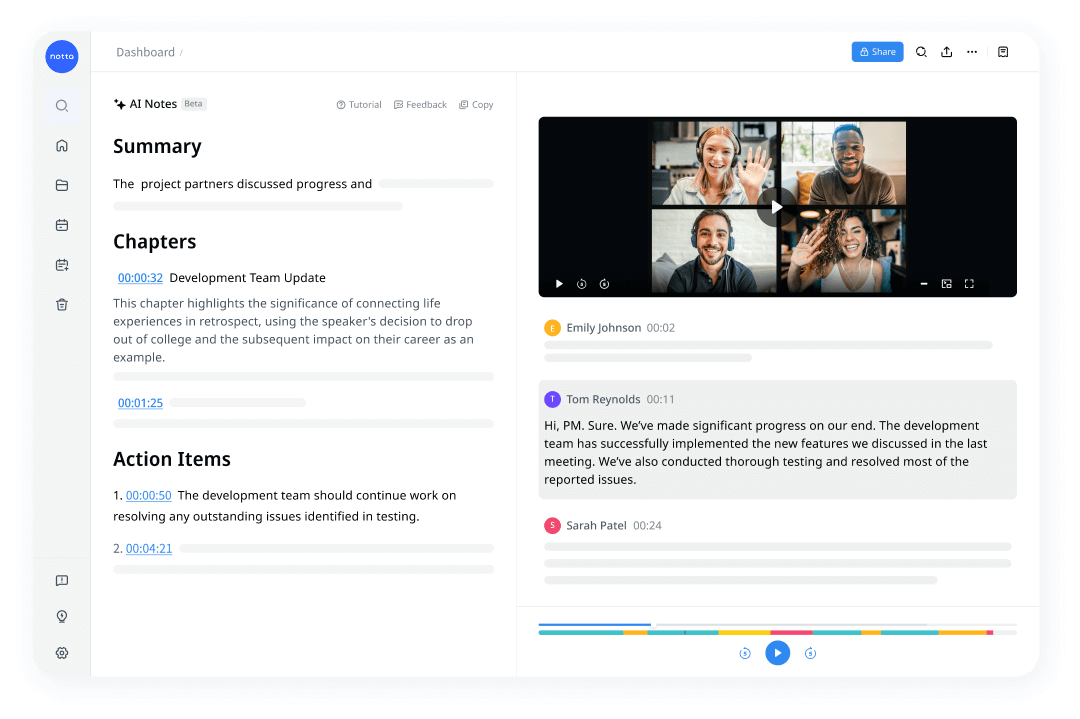Sometimes, it feels like the team is working hard, but the results aren't up to par. That's where the Scrum framework comes in! It follows a structure where the team enters a finite period (two to three weeks) called sprints.
Sprint retrospective is an important part of the popular scrum framework that follows a prospective structure for managing projects. It's typically held when the product team comes together to discuss ways to improve the next sprint.
Sprint retrospective is one step that’s often confused with sprint review — though they are different. I have spent a week talking to the product managers who often schedule sprint retrospective meetings.
Based on my experience and my conversation with them, I'll reveal what sprint retrospective meetings are and how you can host a successful session.
What is a sprint retrospective meeting?
A sprint retrospective meeting is a review session held at the end of every sprint where individual team members share their experiences. The key objective is to identify the strengths and weaknesses to improve the efficiency of the upcoming sprints.
During these sessions, the scrum master, project manager, and team members collectively review and evaluate the completed work. Each team member focuses on what went well, what went wrong, and what can be improved in the future.
The sprints are flexible by nature and design, allowing team members to change priorities on the fly based on retrospectives and also ensuring the team is ready for any unforeseen complications. It's ideal for teams that work on products that are actively being tested by customers for feedback.
What is the purpose of a sprint retrospective?
The goal of the sprint retrospective is to create a list of lessons learned that the scrum team uses to improve how they work in future sprints. The entire team works together to find efficient and effective ways to make tasks easier in the next sprint. Here are a few other reasons why sprint retrospective meetings are held:
Improve collaboration: The agile team evaluates its collaboration at specific intervals, which helps them identify what areas can be improved and actually get the results.
Team first attitude: As a product manager, if there's one thing that actually works, it’s ‘Prioritizing your team.’ The sprint retrospective meetings help teams discuss their challenges and collectively find solutions to execute projects better — and faster!
Teams can speak their minds: You might have a few team members who are not comfortable speaking up even if something isn't working. A sprint retrospective invites the whole team to comfortably discuss what could have been better or what went well in the last sprint.
How to plan a successful sprint retrospective meeting?
Sprint retrospective meetings are a great way to get the entire scrum team on the same page, discuss important ideas, and plan for the next sprint. If you want to make effective use of everyone's time in the meeting, it's important to do proper planning.
1. Prepare & schedule the sprint retrospective
Every meeting needs proper planning and preparation — and sprint retrospective meetings are no exception. Before you schedule the meeting, take some time out to prepare and gather the information you'll need. Then, you need to find the time that works for everyone and then schedule the sprint retrospective meeting.
If you want a tool that helps you schedule meetings, take notes, and manage tasks, take a look at Notta. Once you decide when you'd like to meet, you can connect Notta with Google Calendar. You can then quickly schedule the meeting and share the link with the attendees.
2. Create and send an agenda
You'll also need a way to keep the discussion on track and record what's discussed. The meeting agenda — which can be created collaboratively by the team or independently by the meeting organizer — is at the top. Each topic of discussion comes with an optional timer so everything important is discussed without running over.
3. Ask the right questions
As I've mentioned before, you'll need to ask three important questions from the team members:
If the team starts focusing on unnecessary topics, it's your duty to bring them back to evaluating the past sprint and improving the next one.
4. Outline action items
At the start of the sprint retrospective meeting, each attendee should open a communal document so everyone can take notes. Everyone should note down what are the ways to improve the next steps in the upcoming sprints.
But it's pretty tough to stay engaged and take notes at the same time. Notta's AI summary feature solves that problem. Once the meeting is over, Notta can help you automatically summarize lengthy transcripts and share the summary with all the attendees.

Run effective sprint retrospective meetings
Transcribe meetings, summarize important details and automate scheduling with Notta
Sprint retrospective meeting agenda template
Now that I've discussed everything in detail, here I'll reveal a few sprint retrospective examples and templates you can use anytime. The Mad Sad Glad is a popular sprint retrospective example that focuses more on stressors, blockers, and overall team morale. The job of the scrum master and product manager is to remove roadblocks and increase productivity.
Here's the basic sprint retrospective meeting agenda template you can use:
Title: Sprint Retrospective
Date: May 15, 2024
Time: 10:30 AM - 11:00 AM
Location: Zoom
Attendees: [Here, you can insert the names of all the attendees, including the scrum master, product manager, and the entire scrum team.]
Question 1: What went well?
Here, each team member will write their wins and include how they exceeded expectations. Then, everyone can discuss team wins.
Question 2: What went wrong?
Here, every team member will mention the challenges, roadblocks, or other problems that the team faced during the sprint.
Question 3: What can be improved in the next sprint?
Every team member should brainstorm ideas and offer suggestions that they think can improve the overall results.
Action items
At the end of the sprint meeting, you should list the action items (or the next steps) that each attendee has to complete during the next sprint.
Task 1: @Name
Task 2: @Name
… and so on.
Tips to run an effective sprint retrospective meeting
Sprint retrospective meetings are one of the 5 scrum ceremonies and typically happen right after the sprint review. Here are a few tips to run an effective sprint retrospective meeting.
1. Keep meetings focused
It's always better to focus on items that are of high value and can impact the overall success of the project. Remember, there are a lot of things that need to be discussed during the sprint retrospective meetings. So, make sure everyone focuses on what matters the most.
2. Look for challenges
Of course, there will be some challenges that the team faces while completing the assigned tasks. You'll need to focus on the areas that can be improved and provide solutions to the problems faced by the team members — all during the sprint retrospective meeting.
3. Help the team feel comfortable
You need to make sure the team is comfortable, honest, and transparent during the sprint retrospective meeting. Instead of using ‘you’ pronouns when discussing the problems, use ‘we.’
Mistakes to avoid when planning retrospective meetings
If you want to streamline the planning process of sprint retrospective meetings, here are some common mistakes you should avoid. It'll help you communicate your thoughts more clearly and put the focus on completing action items.
Lack of clear agenda: If there's no clear agenda, the team might get lost during the sprint retrospective. If you're hosting the meeting, you'll need to focus on preparing and sending the agenda at least 48 hours before the meeting starts.
No follow-up: If the attendees do not work on the assigned action items and fail to follow up, there's no point in hosting the meeting. For this reason, you'll need to create an action item and stick to it.
Playing blame game: Let's be honest; things can go wrong when a team works together, but playing blame games can impact the overall team collaboration. Instead of pointing out the mistakes, the team should work together to find better solutions.
Key takeaways
The scrum method can help teams handle complex tasks by organizing them into short and flexible sprints. As a product manager, I find sprint retrospective meetings suitable for complex tasks because they allow me to break down projects into manageable component parts. It's a great approach that helps everyone in the team gather and discuss how things can be improved.
If you're planning to host a successful sprint retrospective session, make sure you automate certain meeting-related tasks and save valuable time. Notta is one such tool that can help you schedule meetings, record and transcribe conversations, and then summarize transcripts. If you want to try the AI tool, simply create a free Notta account today!
Capture every detail with AI meeting notes
Notta offers the most integrated AI meeting notes, summaries, and action items so nothing gets missed.
FAQs
Who should attend a sprint retrospective meeting?
The scrum master, product manager, and the entire scrum team involved in designing, building, and testing the product should attend the sprint retrospective meeting. In short, the retrospective is a gathering of the people who executed the work during the sprint.
How long should a sprint retrospective meeting be?
The length of the sprint retrospective meeting might vary depending on the duration of each sprint. These retrospective meetings can be as short as 45 minutes for short sprints or as long as 3 hours for one-month-long sprints.
What questions should you ask in a sprint retrospective?
There are many questions you can ask in the sprint retrospective meeting, such as:
Who helped you out during the sprint?
On a scale of 1 - 10, how do you feel about the sprint?
What did you learn during this sprint?
Did anything happen during this sprint that caught you off guard?
What resources do you wish you had during this sprint?

